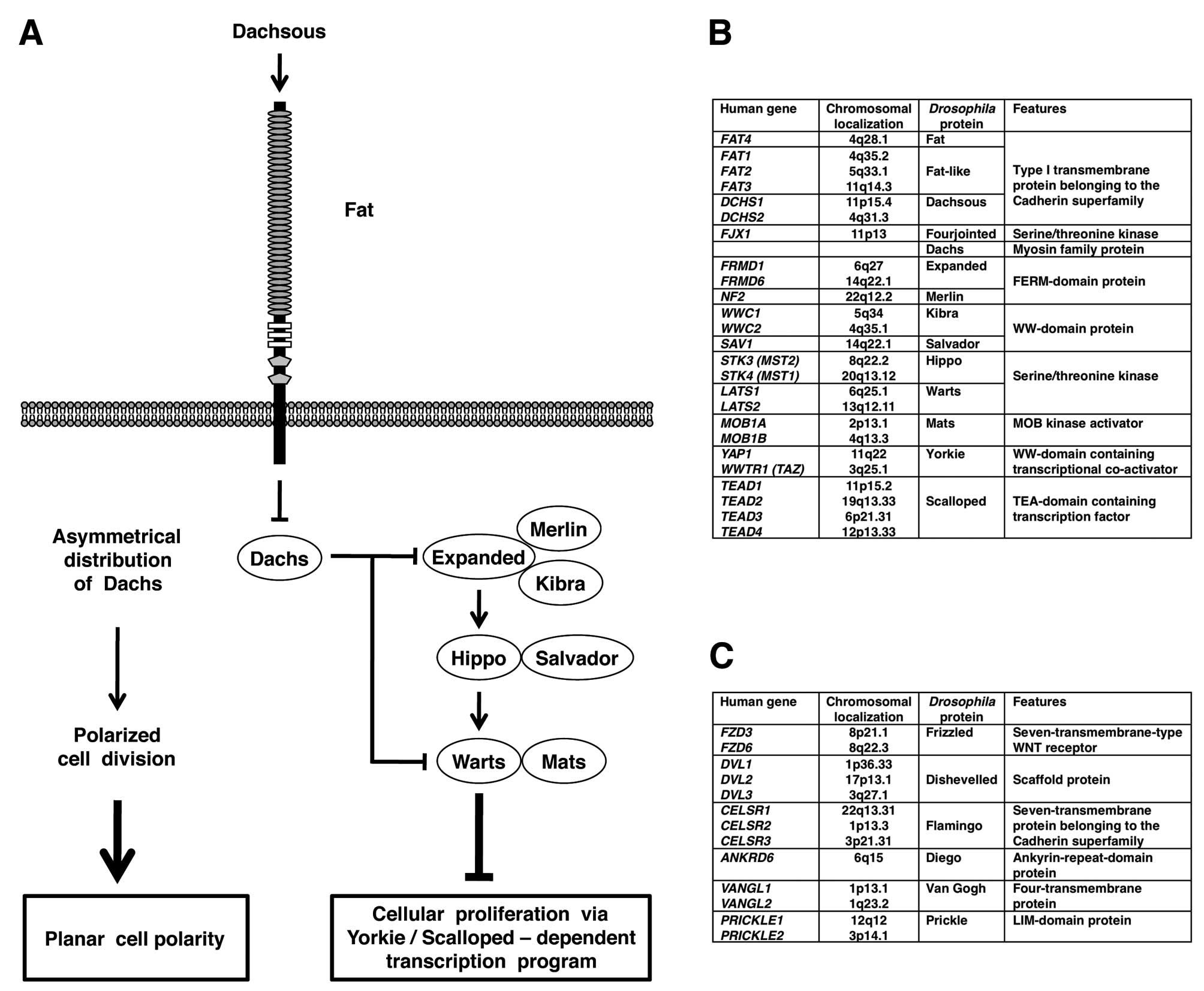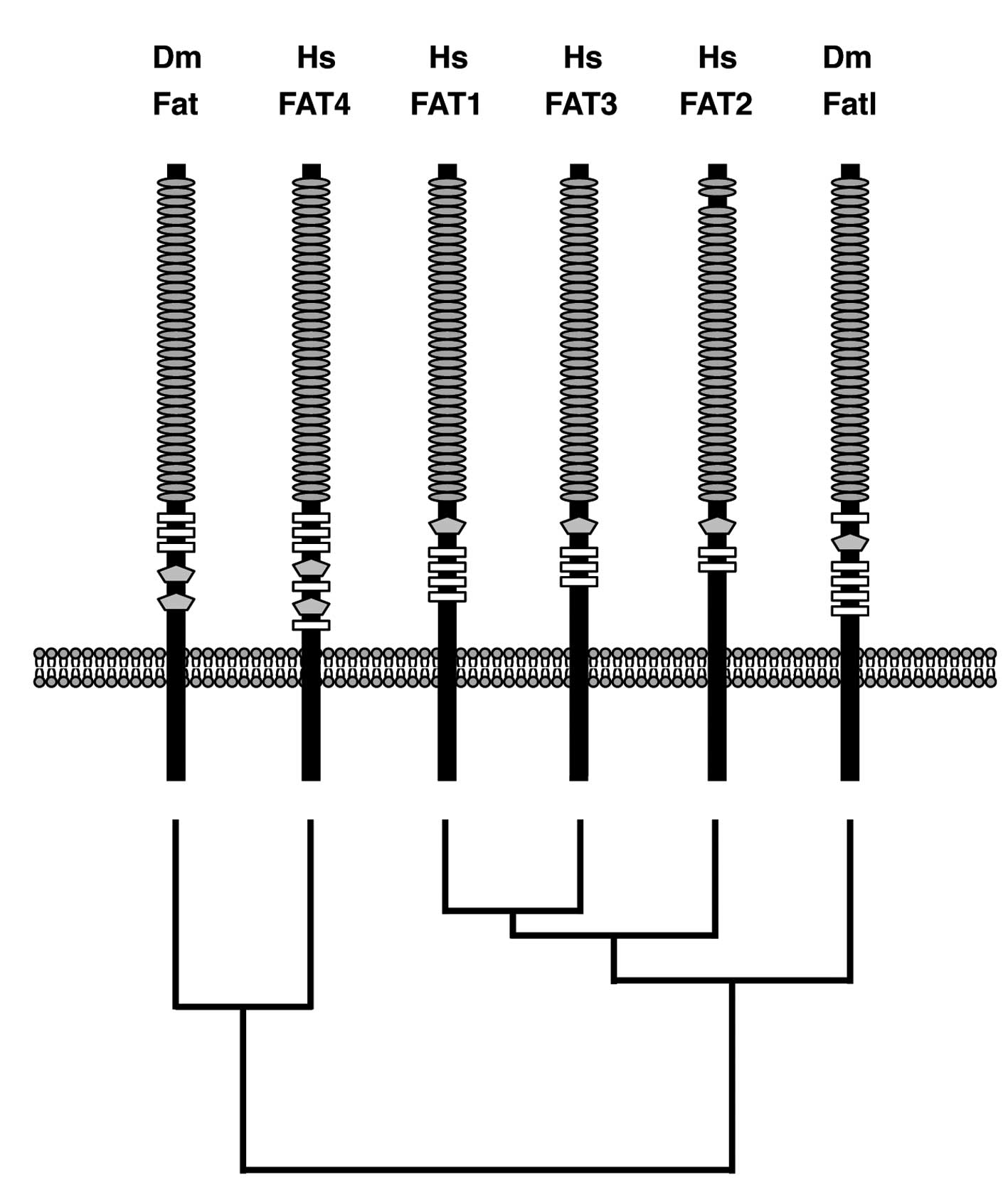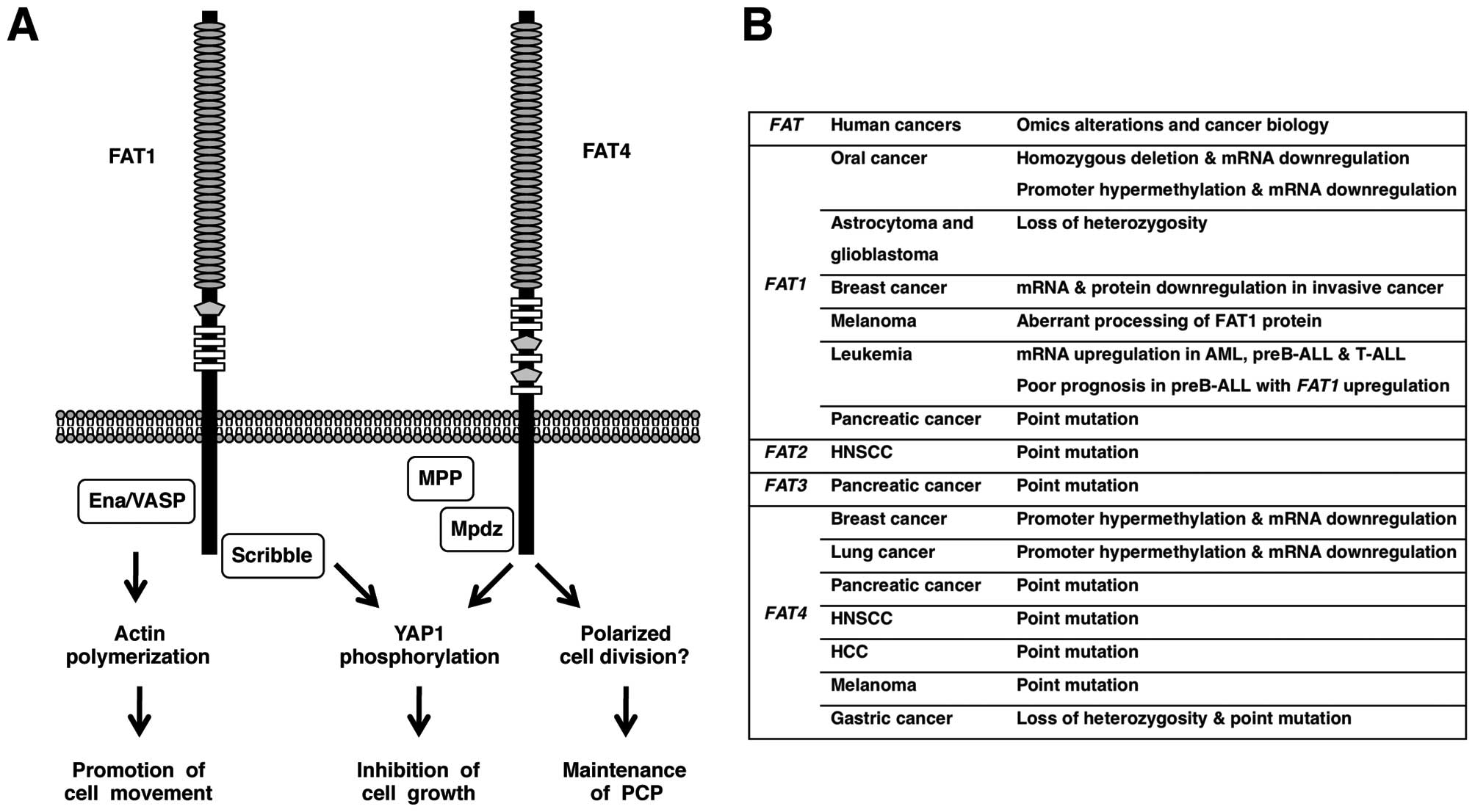|
1.
|
PJ BryantB HuettnerLI Held JrJ RyerseJ
SzidonyaMutations at the fat locus interfere with cell
proliferation control and epithelial morphogenesis in
DrosophilaDev Biol1295415541988
|
|
2.
|
DF WoodsPJ BryantThe discs-large
tumor suppressor gene of Drosophila encodes a guanylate
kinase homolog localized at septate junctionsCell664514641991
|
|
3.
|
D StrandI RaskaBM MechlerThe Drosophila
lethal(2) giant larvae tumor suppressor protein is a component
of the cytoskeletonJ Cell Biol127134513601994
|
|
4.
|
RW JusticeO ZilianDF WoodsM NollPJ
BryantThe Drosophila tumor suppressor gene warts
encodes a homolog of human myotonic dystrophy kinase and is
required for the control of cell shape and proliferationGenes
Dev95345461995
|
|
5.
|
D BilderN PerrimonLocalization of apical
epithelial determinants by the basolateral PDZ protein
ScribbleNature403676680200010.1038/3500110810688207
|
|
6.
|
N TaponKF HarveyDW Bellsalvador
promotes both cell cycle exit and apoptosis in Drosophila
and is mutated in human cancer cell
linesCell110467478200210.1016/S0092-8674(02)00824-3
|
|
7.
|
S PantalacciN TaponP LéopoldThe Salvador
partner Hippo promotes apoptosis and cell-cycle exit in
DrosophilaNat Cell
Biol5921927200310.1038/ncb105114502295
|
|
8.
|
PJ BryantKL WatsonRW JusticeDF WoodsTumor
suppressor genes encoding proteins required for cell interactions
and signal transduction in DrosophilaDev
Suppl23924919938049479
|
|
9.
|
IK HariharanD BilderRegulation of imaginal
disc growth by tumor-suppressor genes in DrosophilaAnnu Rev
Genet40335361200610.1146/annurev.genet.39.073003.10073816872256
|
|
10.
|
LJ SaucedoBA EdgarFilling out the Hippo
pathwayNat Rev Mol Cell Biol8613621200710.1038/nrm222117622252
|
|
11.
|
BV ReddyKD IrvineThe Fat and Warts
signaling pathways: new insights into their regulation, mechanism
and
conservationDevelopment13528272838200810.1242/dev.02097418697904
|
|
12.
|
D PanThe hippo signaling pathway in
development and cancerDev
Cell19491505201010.1016/j.devcel.2010.09.01120951342
|
|
13.
|
A GenevetN TaponThe Hippo pathway and
apico-basal cell polarityBiochem
J436213224201110.1042/BJ2011021721568941
|
|
14.
|
CH YangJD AxelrodMA SimonRegulation of
Frizzled by fat-like cadherins during planar polarity signaling in
the Drosophila compound
eyeCell108675688200210.1016/S0092-8674(02)00658-X11893338
|
|
15.
|
H StruttD StruttNonautonomous planar
polarity patterning in Drosophila: dishevelled-independent
functions of frizzledDev
Cell3851863200210.1016/S1534-5807(02)00363-512479810
|
|
16.
|
JD AxelrodProgress and challenges in
understanding planar cell polarity signalingSemin Cell Dev
Biol20964971200910.1016/j.semcdb.2009.08.00119665570
|
|
17.
|
A DjianeM MlodzikThe Drosophila
GIPC homologue can modulate myosin based processes and planar cell
polarity but is not essential for developmentPLoS
One5e112282010
|
|
18.
|
JD AxelrodJR MillerJM ShulmanRT MoonN
PerrimonDifferential recruitment of Dishevelled provides signaling
specificity in the planar cell polarity and Wingless signaling
pathwaysGenes Dev1226102622199810.1101/gad.12.16.26109716412
|
|
19.
|
M MlodzikPlanar cell polarization: do the
same mechanisms regulate Drosophila tissue polarity and
vertebrate gastrulation?Trends
Genet18564571200210.1016/S0168-9525(02)02770-112414186
|
|
20.
|
M KatohWNT/PCP signaling pathway and human
cancer (Review)Oncol Rep1415831588200516273260
|
|
21.
|
HO IshikawaH TakeuchiRS HaltiwangerKD
IrvineFour-jointed is a Golgi kinase that phosphorylates a subset
of cadherin
domainsScience321401404200810.1126/science.115815918635802
|
|
22.
|
R SopkoH McNeillThe skinny on Fat: an
enormous cadherin that regulates cell adhesion, tissue growth, and
planar cell polarityCurr Opin Cell
Biol21717723200910.1016/j.ceb.2009.07.00119679459
|
|
23.
|
C ThomasD StruttThe roles of the cadherins
Fat and Dachsous in planar polarity specification in
DrosophilaDev Dyn2412739201210.1002/dvdy.2273621919123
|
|
24.
|
F BosveldI BonnetB GuiraoMechanical
control of morphogenesis by Fat/Dachsous/Four-jointed planar cell
polarity
pathwayScience336724727201210.1126/science.122107122499807
|
|
25.
|
PA MahoneyU WeberP OnofrechukH BiessmannPJ
BryantCS GoodmanThe fat tumor suppressor gene in
Drosophila encodes a novel member of the cadherin gene
superfamilyCell678538681991
|
|
26.
|
T TanoueM TakeichiNew insights into Fat
cadherinsJ Cell Sci11823472353200510.1242/jcs.0239815923647
|
|
27.
|
P HulpiauF van RoyMolecular evolution of
the cadherin superfamilyInt J Biochem Cell
Biol41349369200910.1016/j.biocel.2008.09.027
|
|
28.
|
J DunneAM HanbyR PoulsomMolecular cloning
and tissue expression of FAT, the human homologue of the
Drosophila fat gene that is located on chromosome 4q34-q35
and encodes a putative adhesion moleculeGenomics302072231995
|
|
29.
|
Q WuT ManiatisLarge exons encoding
multiple ectodomains are a characteristic feature of protocadherin
genesProc Natl Acad Sci
USA9731243129200010.1073/pnas.97.7.312410716726
|
|
30.
|
JC HöngNV IvanovP HodorIdentification of
new human cadherin genes using a combination of protein motif
search and gene finding methodsJ Mol Biol337307317200415003449
|
|
31.
|
Y KatohM KatohComparative integromics on
FAT1, FAT2, FAT3 and FAT4Int J Mol
Med185235282006
|
|
32.
|
E SadeqzadehCE de BockXD ZhangDual
processing of FAT1 cadherin protein by human melanoma cells
generates distinct protein productsJ Biol
Chem2862818128191201110.1074/jbc.M111.23441921680732
|
|
33.
|
T MaggD SchreinerGP SolisEG BadeHW
HoferProcessing of the human protocadherin Fat1 and translocation
of its cytoplasmic domain to the nucleusExp Cell
Res307100108200510.1016/j.yexcr.2005.03.00615922730
|
|
34.
|
T TanoueM TakeichiMammalian Fat1 cadherin
regulates actin dynamics and cell-cell contactJ Cell
Biol165517528200410.1083/jcb.20040300615148305
|
|
35.
|
MJ MoellerA SoofiGS BraunProtocadherin
FAT1 binds Ena/VASP proteins and is necessary for actin dynamics
and cell polarizationEMBO
J2337693779200410.1038/sj.emboj.760038015343270
|
|
36.
|
D SchreinerK MüllerHW HoferThe
intracellular domain of the human protocadherin hFat1 interacts
with Homer signalling scaffolding proteinsFEBS
Lett58052955300200610.1016/j.febslet.2006.08.07916979624
|
|
37.
|
K SkouloudakiM PuetzM SimonsScribble
participates in Hippo signaling and is required for normal
zebrafish pronephros developmentProc Natl Acad Sci
USA10685798584200910.1073/pnas.081169110619439659
|
|
38.
|
R HouL LiuS AneesS HiroyasuNE SibingaThe
Fat1 cadherin integrates vascular smooth muscle cell growth and
migration signalsJ Cell
Biol173417429200610.1083/jcb.20050812116682528
|
|
39.
|
T IshiuchiK MisakiS YonemuraM TakeichiT
TanoueMammalian Fat and Dachsous cadherins regulate apical membrane
organization in the embryonic cerebral cortexJ Cell
Biol185959967200910.1083/jcb.20081103019506035
|
|
40.
|
M KatohM KatohIdentification and
characterization of human MPP7 gene and mouse Mpp7
gene in silicoInt J Mol Med133333382004
|
|
41.
|
S SaburiI HesterE FischerLoss of
Fat4 disrupts PCP signaling and oriented cell division and
leads to cystic kidney diseaseNat Genet40101010152008
|
|
42.
|
C JonesP ChenPlanar cell polarity
signaling in
vertebratesBioessays29120132200710.1002/bies.2052617226800
|
|
43.
|
Z KibarKJ VoganN GroulxMJ JusticeDA
UnderhillP GrosLtap, a mammalian homolog of Drosophila
Strabismus/Van Gogh, is altered in the mouse neural tube mutant
Loop-tailNat Genet28251255200110.1038/90081
|
|
44.
|
NJ van HaterenRM DasGM HautbergueAG
BoryckiM PlaczekSA WilsonFatJ acts via the Hippo mediator Yap1 to
restrict the size of neural progenitor cell
poolsDevelopment13818931902201121521736
|
|
45.
|
K NakayaHD YamagataN AritaIdentification
of homozygous deletions of tumor suppressor gene FAT in oral
cancer using
CGH-arrayOncogene2653005308200710.1038/sj.onc.121033017325662
|
|
46.
|
K ChosdolA MisraS PuriFrequent loss of
heterozygosity and altered expression of the candidate tumor
suppressor gene ‘FAT’ in human astrocytic tumorsBMC
Cancer95200910.1186/1471-2407-9-519126244
|
|
47.
|
S LeeS StewartI NagtegaalDifferentially
expressed genes regulating the progression of ductal carcinoma in
situ to invasive breast cancerCancer
Res7245744586201210.1158/0008-5472.CAN-12-063622751464
|
|
48.
|
CE de BockA ArdjmandTJ MolloyThe Fat1
cadherin is overexpressed and an independent prognostic factor for
survival in paired diagnosis-relapse samples of precursor B-cell
acute lymphoblastic leukemiaLeukemia26918926201222116550
|
|
49.
|
J SettakornN KaewpilaGF BurnsAS LeongFAT,
E-cadherin, β-catenin, HER 2/neu, Ki67 immuno-expression, and
histological grade in intrahepatic cholangiocarcinomaJ Clin
Pathol58124912542005
|
|
50.
|
A RohrbeckJ BorlakCancer genomics
identifies regulatory gene networks associated with the transition
from dysplasia to advanced lung adenocarcinomas induced by
c-Raf-1PLoS One4e7315200910.1371/journal.pone.000731519812696
|
|
51.
|
C QiYT ZhuL HuYJ ZhuIdentification of
Fat4 as a candidate tumor suppressor gene in breast
cancersInt J Cancer1247937982009
|
|
52.
|
TA RauchZ WangX WuKH KernstineAD RiggsGP
PfeiferDNA methylation biomarkers for lung cancerTumour
Biol33287296201210.1007/s13277-011-0282-222143938
|
|
53.
|
S JonesX ZhangDW ParsonsCore signaling
pathways in human pancreatic cancers revealed by global genomic
analysesScience32118011806200810.1126/science.116436818772397
|
|
54.
|
N AgrawalMJ FrederickCR PickeringExome
sequencing of head and neck squamous cell carcinoma reveals
inactivating mutations in
NOTCH1Science33311541157201110.1126/science.120692321798897
|
|
55.
|
M LiH ZhaoX ZhangInactivating mutations of
the chromatin remodeling gene ARID2 in hepatocellular
carcinomaNat Genet43828829201110.1038/ng.903
|
|
56.
|
SI NikolaevD RimoldiC IseliExome
sequencing identifies recurrent somatic MAP2K1 and
MAP2K2 mutations in melanomaNat
Genet44133139201110.1038/ng.1026
|
|
57.
|
ZJ ZangI CutcutacheSL PoonExome sequencing
of gastric adenocarcinoma identifies recurrent somatic mutations in
cell adhesion and chromatin remodeling genesNat
Genet44570574201210.1038/ng.224622484628
|
|
58.
|
M ImajoK MiyatakeA IimuraA MiyamotoE
NishidaA molecular mechanism that links Hippo signalling to the
inhibition of Wnt/β-catenin signallingEMBO
J3111091122201222234184
|
|
59.
|
M KatohM KatohWNT signaling pathway and
stem cell signaling networkClin Cancer
Res1340424045200710.1158/1078-0432.CCR-06-231617634527
|
|
60.
|
FX YuB ZhaoN PanupinthuRegulation of the
Hippo-YAP pathway by G-Protein-coupled receptor
signalingCell150780791201210.1016/j.cell.2012.06.03722863277
|
|
61.
|
W HuangX LvC LiuThe N-terminal
phosphodegron targets TAZ/WWTR1 protein for SCF β-TrCP-dependent
degradation in response to phosphatidylinositol 3-kinase
inhibitionJ Biol Chem2872624526253201222692215
|
|
62.
|
M CordenonsiF ZanconatoL AzzolinThe Hippo
transducer TAZ confers cancer stem cell-related traits on breast
cancer cellsCell147759772201110.1016/j.cell.2011.09.04822078877
|












